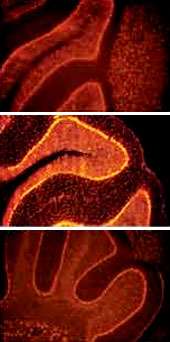New method prevents microRNAs from escaping cells

(PhysOrg.com) -- MicroRNAs — one of the tiniest entities in the human genome — are great escape artists. Despite scientists’ best efforts to detect and capture them in different tissues, they often manage to make a getaway, sneaking through the tissues’ tiny holes before anyone can detect them. But now, by adapting a time-tested histological technique, Rockefeller University researchers have scored big: They have developed a new method to capture microRNAs before they disappear. The work will help researchers better understand microRNAs’ increasingly indisputable role in the onset of disease.
The research, to be published in the February issue of Nature Methods, initially began when Thomas Tuschl, head of the Laboratory of RNA Molecular Biology, and first author John Pena, an M.D.-Ph.D. fellow in the lab, wanted to study the relationship between psychiatric diseases and microRNAs, the tiny gene-regulating molecules discovered 10 years ago. But the tools to detect and measure microRNAs yielded such inconsistent results that the two decided to take a step back. “In order to move forward,” says Pena, “we had to go to the basics.”
Their method builds upon a procedure known as in situ hybridization, a technique first developed in the 1960s that uses molecular spies, called probes, to find messenger RNAs in tissues. During in situ hybridization, scientists treat the tissues with the chemical formaldehyde, which cross-links proteins within the tissue and creates a molecular scaffold that prevents messenger RNAs from leaking through the tissues’ holes. But when it comes to tiny microRNAs, this technique fails. “Because microRNAs are so small, they come out of the tissue,” says Pena. “They just fall through the scaffold.”
That’s not all. For the probe to bind to its target microRNA, the tissue needs to be heated to a certain temperature. But heat, it turns out, is precisely what loosens the scaffold, creating larger gaps through which the microRNAs can escape.
On the advice of Janos Ludwig, a chemist and former member of the Tuschl lab who is now at the Institute of Clinical Chemistry and Pharmacology at the University of Bonn in Germany, the team altered the procedure. Instead of using formaldehyde alone, the team cleverly added EDC, a chemical that gives the microRNAs something to attach to: the scaffold itself. Used alone, the EDC failed. But when combined with formaldehyde, the team saw that significantly more microRNAs were retained in the tissue. Supposedly, that’s because the two chemicals have a tag-team effect. The formaldehyde creates the scaffold, and then the EDC attaches the microRNAs to it. Since the microRNAs attach to the scaffold, it doesn’t matter that the scaffold changes after the tissue is heated.
“By adding this unusual fixation step, we were able to immobilize the microRNAs in the tissue and then visualize them by routine pathology means,” says Tuschl, who is also a Howard Hughes Medical Institute investigator.
In their work, Tuschl, Pena and their team of technicians tested more than 130 microRNAs in a medley of tissues, including heart, liver, muscle and brain. When they compared tissues treated with formaldehyde and EDC versus formaldehyde alone, they saw that microRNAs were more consistently retained in the tissues treated with both. The effect was especially noticeable for microRNAs that are expressed in small quantities. Losing any of these, explains Pena, could yield an undetectable quantity in the cell, leading to inconsistent or negative results.
Since their discovery, microRNAs have been hailed as the dark matter of the RNA universe, as they were first undetectable but then recognized to play a role in countless diseases, ranging from cancer to neurological disorders. “If microRNAs are going to be used as a diagnostic tool, we need a reliable way to measure them in normal and disease tissue, regardless of where or to what degree they are expressed,” says Pena. “So that’s what we did: We went back and examined and questioned every single step of this protocol to see where we could optimize it.”
Reference: Nature Methods online: January 11, 2009, www.nature.com/nmeth/journal/v … /abs/nmeth.1294.html
Provided by Rockefeller University





















